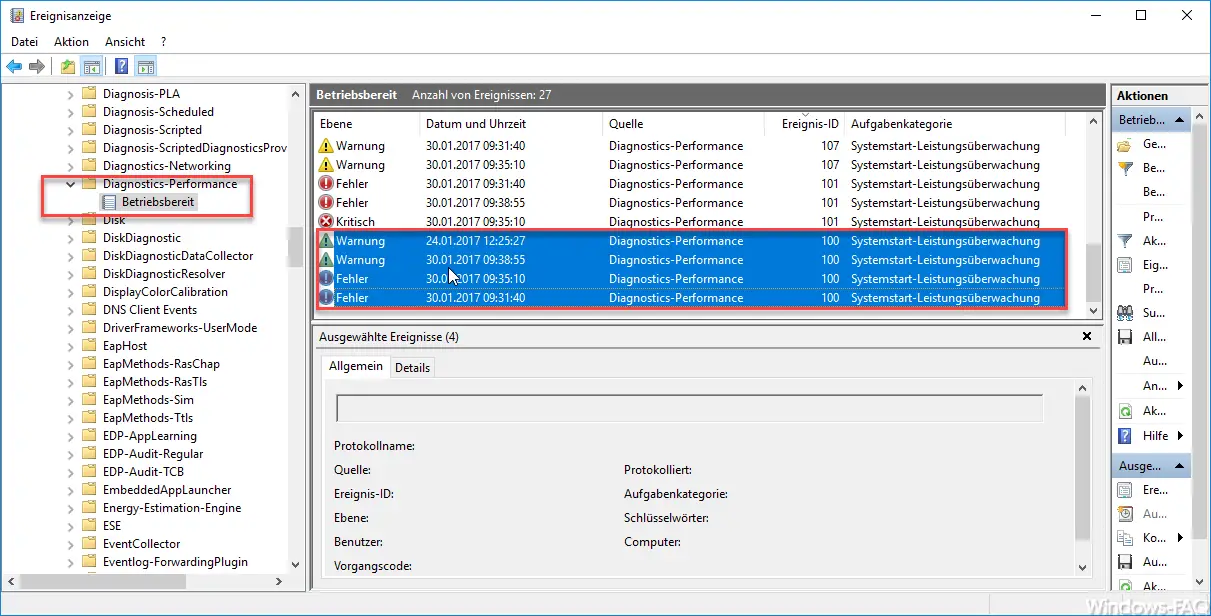The Windows event ID 100 is usually very common in the event logs of Windows systems. This is nothing unusual, because it is one of the standard functions of the newer Windows systems that they take performance measurements during the Windows boot process and then, for example, via the
Event ID 100 (startup performance monitor)
file in the Windows event log. As a rule, Windows examines the exact times how long each process took each time the system was booted and also shutdown and logs this via event ID 100 and 200 in the event log .
Below you can see an example of a normal Windows 10 PC with various ID 100 entries .

The easiest way to find these entries is to go to the following area in the Windows Event Viewer
Application and service protocols / Microsoft / Windows / Diagnostics performance
In this example you will find 4 entries of the type ” Event ID 100 “. Two entries are marked as warnings, 2 more as errors. This is because Windows believes that it took twice too long to start Windows . In the example that we will show you below, this takes over 61000 milliseconds and this is simply too long.

It becomes interesting when you look at the details of Windows Event 100 , because there is a lot of information about the individual boot processes visible, as you can see below.

Here you will find the following values, which also show the exact millisecond values for each process.
- BootTsVersion
- BootStartTime
- BootEndTime
- SystemBootInstance
- UserBootInstance
- BootTime
- MainPathBootTime
- BootKernelInitTime
- BootDriverInitTime
- BootDevicesInitTime
- BootPrefetchInitTime
- BootPrefetchBytes
- BootAutoChkTime
- BootSmssInitTime
- BootCriticalServicesInitTime
- BootUserProfileProcessingTime
- BootMachineProfileProcessingTime
- BootExplorerInitTime
- BootNumStartupApps
- BootPostBootTime
- BootIsRebootAfterInstall
- BootRootCauseStepImprovementBits
- BootRootCauseGradualImprovementBits
- BootRootCauseStepDegradationBits
- BootRootCauseGradualDegradationBits
- BootIsDegradation
- BootIsStepDegradation
- BootIsGradualDegradation
- BootImprovementDelta
- BootDegradationDelta
- BootIsRootCauseIdentified
- OSLoaderDuration
- BootPNPInitStartTimeMS
- BootPNPInitDuration
- OtherKernelInitDuration
- SystemPNPInitStartTimeMS
- SystemPNPInitDuration
- SessionInitStartTimeMS
- Session0InitDuration
- Session1InitDuration
- SessionInitOtherDuration
- WinLogonStartTimeMS
- OtherLogonInitActivityDuration
- UserLogonWaitDuration
Here you can see, among other things, when the Windows boot process started, when it ended, how long it took to start Windows Explorer, etc.
Thus, the Windows ID 100 is actually not an error, but gives very extensive information about where a Windows system has weaknesses and which event contributes to the fact that a PC or a Windows server takes too long to start up . If you examine these values intensively, you may come to the reason why your Windows takes longer to start up than necessary.
If you are interested in further information about Window ID error codes , please take a look at the following articles.
– The time service is no longer announced as a time source…. Event ID 142
– Hyper-V MAC conflict Event ID 16945 (MsLbfoSysEvtProvider)
– WHEA Logger – Event ID 47
– Crypt32 – Event ID 8 – Explanation and error
correction – 0xC004F057 Event ID: 1058 – Error installing the proof of purchase
– Citrix Event ID 9017 in the event log of a XenApp server
– Task
planning Event ID identifier Error 101 – Event log (Eventlog) Quickly delete entries using Powershell
– Error “The server was not able to remove swapped pool memory …” ID 2020